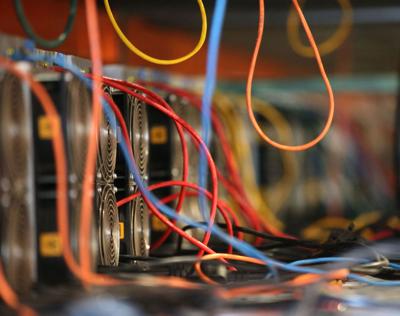Bitcoin mining is the process of creating new bitcoins by solving extremely complicated math problems that verify transactions in the currency. When a bitcoin is successfully mined, the miner receives a predetermined amount of bitcoin.
Bitcoin is one of the most popular types of cryptocurrencies, which are digital mediums of exchange that exist solely online. Bitcoin runs on a decentralized computer network, or distributed ledger, that tracks transactions in the cryptocurrency.Â

Wires connect computer servers June 14, 2021, at the Sangha Systems cryptocurrency mining facility in Hennepin, Illinois.Â
Here are the basics of how bitcoin mining works and some key risks to be aware of.
How bitcoin mining works
Bitcoin is powered by blockchain, which is the technology behind many cryptocurrencies. A blockchain is a decentralized ledger of all the transactions across a network. Groups of approved transactions together form a block and are joined by computers within the network (called miners) to create a chain. Bitcoin mining is the process of adding a block to the chain.
People are also reading…
Bitcoin miners pick transactions from a group of unconfirmed transactions, called a mempool, to form a block on the blockchain. Before they can add the block securely to the blockchain, miners must solve what’s called a proof-of-work puzzle by guessing a number (also called a nonce). This number is combined with the block’s data and processed through a function called SHA-256.
The ultimate goal: create a block hash, which is a code with enough leading zeros to be less than, or equal to, the network’s target hash. The target hash is what determines how difficult the puzzle is to solve.Â
Remember the block hash must be less than or equal to the target hash. Think of it like a dice game where the only way to win is if you roll a number smaller than or equal to a some number you’re given at the beginning. That number is made mostly of zeros, so you’d need a really insane and rare roll — a hash with tons of zeros in front of it — to win.Â
Miners use extremely powerful computers, called ASICs, to make billions — or trillions — of guesses about which nonces could work. One computer can cost up to $10,000.Â
ASICs also consume huge amounts of electricity, which has drawn criticism from environmental groups and limits the profitability of miners.Â
If a miner is able to successfully add a block to the blockchain, they will receive 3.125 bitcoins. The reward amount is cut in half about every four years, or every 210,000 blocks. As of mid-June 2025, bitcoin traded at about $107,000, making 3.125 bitcoins worth $334,375.
Risks of bitcoin mining
- Regulation: Very few governments have embraced cryptocurrencies such as bitcoin, and many are more likely to view them skeptically because the currencies operate outside government control. There is always the risk that governments could outlaw the mining of bitcoin or cryptocurrencies altogether as China did in 2021, citing financial risks and increased speculative trading.
- Price volatility: Bitcoin’s price has fluctuated widely since it was introduced in 2009. Since just January 2023, bitcoin has at times traded for less than $18,000 and more than $110,000 recently. This kind of volatility makes it difficult for miners to know if their reward will outweigh the high costs of mining.
Is bitcoin profitable?
It depends. Even if bitcoin miners are successful, it’s not clear that their efforts will end up being profitable due to the high upfront costs of equipment and the ongoing electricity costs.
Worldwide, bitcoin mining uses more electricity than Poland, a nation of 36.7 million people, according to the University of Cambridge’s Bitcoin Electricity Consumption Index.Â
As the difficulty and complexity of bitcoin mining has increased, the computing power required has also gone up. Bitcoin mining consumes about 184.4 terawatt-hours of electricity each year, more than most countries, according to the Cambridge index.
One way to share some of the high costs of mining is by joining a mining pool. Pools allow miners to share resources and add more capability, but shared resources mean shared rewards, so the potential payout is less when working through a pool. The volatility of bitcoin’s price also makes it difficult to know exactly how much you’re working for.
Bottom line
While bitcoin mining sounds appealing, the reality is that it’s difficult and expensive to actually do profitably. The extreme volatility of bitcoin’s price adds more uncertainty to the equation.
Keep in mind that bitcoin itself is a speculative asset with no intrinsic value, which means it won’t produce anything for its owner and isn’t pegged to something like gold. Your return is based on selling it to someone else for a higher price, and that price may not be high enough for you to turn a profit.

















